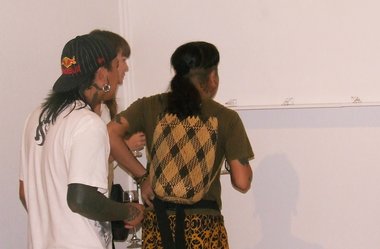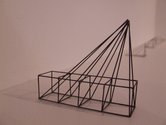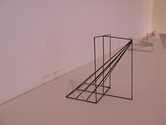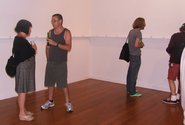Peter Dornauf – 5 March, 2012
These works do not declaim or proclaim themselves in loud voice. One could almost be forgiven for thinking nothing was on show in a room so minimal and the creations so small. They are miniatures of architectural abstraction no more than centimetres in size, exquisitely rendered exercises in geometric forms.
Size matters, they say, though others would claim it’s more the skill of the magician. Peter Trevelyan has it both ways, his work of recent years ranging from the gargantuan to the Lilliputian in its format. In his current exhibition at Ramp Gallery, Waikato Wintec, he plays the conjuror, working on an extraordinary diminutive scale with his delicate materials.
Small is beautiful is not a mantra that springs immediately to mind when contemplating the visual arts. From McCahon to Cotton to Reynolds, to Albrecht to Pule and back, the rule is big. Precedents start with Michelangelo and reach right up to Pollock. But Selected Proofs, by Trevelyan must rate as some of the smallest sculptural constructions on record. There are thirty four of them in total, arranged on a narrow white shelf set along two of the gallery walls. The rest of the gallery is empty. Needless to say, these works do not declaim or proclaim themselves in loud voice. One could almost be forgiven for thinking nothing was on show in a room so minimal and the creations so small. They are miniatures of architectural abstraction no more than centimetres in size, exquisitely rendered exercises in geometric forms.
Exquisite enough in themselves, it is once the viewer becomes cognisant of the materials employed that the response can only be one of astonishment. Meticulously crafted, Trevelyan uses short lengths of thin pencil lead, glued together, to form his sculptural pieces. These studies in scaled-down abstract architectural forms, using triangles, pyramids and grids, create small cages of mathematical prisms, looking not too unlike structural frames for toy glasshouses. Examining them, one is reminded of studies in perspective, that invention of the Renaissance, which became the foundation for the new illusion of space for subsequent art practice. Trevelyan takes his cue from here, from Brunelleschi and others while at the same time recalling the marriage of art and architecture in twentieth century Constructivism that helped ironically give birth to the flattening of space with the advent of modernism.
But beyond these formal considerations, the works, because of their inherent fragility, raise other questions that have to do with another tension, that of friction between modern and postmodern. The works become metaphors for the unease and strain between absolutes, symbolized by geometry, (one recalls Plato’s dictum, “geometry is that which always persists”) and the ephemeral, embodied in the lightweight materials used to construct these vulnerable creations. Here is configured a fusion of opposites, the personification of contradiction, a meeting of temporal and the eternal that encapsulates the dilemma of current thought searching for ways to juggle antithetical claims and find a footing in the undecidability of it all.
Peter Dornauf






 Two Rooms presents a program of residencies and projects
Two Rooms presents a program of residencies and projects Advertising in this column
Advertising in this column



This Discussion has 0 comments.
Comment
Participate
Register to Participate.
Sign in
Sign in to an existing account.